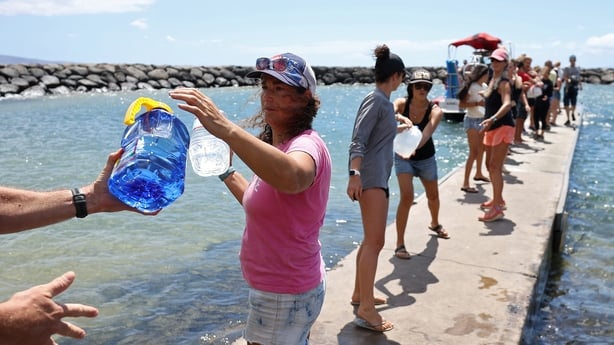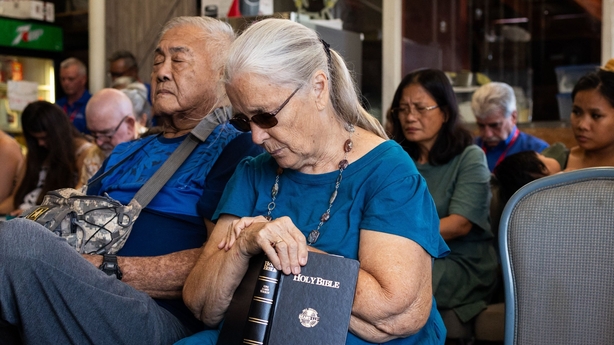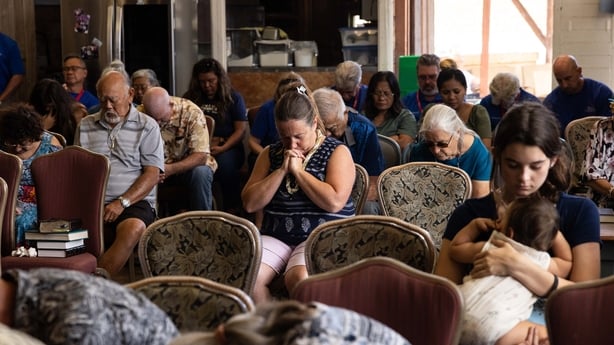Recovery crews in Hawaii are likely to find between 10 and 20 more victims per day, the state's governor has said - meaning the toll from the deadliest US wildfire in a century is expected to rise sharply.
At least 96 people are already confirmed to have died, but Governor Josh Green said emergency responders with cadaver dogs will need more than a week to work their way through hundreds of homes and burned-out vehicles in hard-hit Lahaina.
"There are more fatalities that will come," he told CBS in an interview aired today.
He added: "They will find 10 to 20 people per day probably until they finish. And it's probably going to take 10 days. It's impossible to guess, really."
The historic coastal town of Lahaina on the island of Maui was almost destroyed by the fast-moving inferno last week, with survivors saying there had been no warnings.
With some mobile phone communications now restored, residents have been able to connect with family and friends, and the number of people still missing has been reduced from more than 2,000 to around 1,300, Mr Green said.
"Our hearts will break beyond repair, perhaps, if that means that many more dead. None of us think that, but we are prepared for many tragic stories," he said.
The town, which served as the Hawaiian kingdom's capital in the early 19th century, was home to around 12,000 residents.
More than 2,200 buildings were damaged or destroyed as the fire tore through Lahaina, according to official estimates, wreaking $5.5 billion (€5.04bn) in damage and leaving thousands homeless.
When asked yesterday why none of the island's sirens had been activated, Hawaii Senator Mazie Hirono said she would wait for the results of an investigation announced by the state's attorney general.
"I'm not going to make any excuses for this tragedy," Ms Hirono, a Democrat, told CNN's 'State of the Union'.
"We are really focused, as far as I'm concerned, on the need for rescue, and, sadly, the location of more bodies."

"The remains we're finding are from a fire that melted metal," said Maui Police Chief John Pelletier.
"When we pick up the remains... they fall apart."
That was making identification difficult, he added, appealing for those with missing relatives to give DNA samples that might speed up the process.
Mr Pelletier said cadaver dogs still had a vast area to search in the hunt for what could still be hundreds of people who are unaccounted for.
"We're going as fast as we can. But just so you know, 3% -- that's what's been searched with the dogs," he said.
Questions over alert system
The wildfire is the deadliest in the United States since 1918, when 453 people died in Minnesota and Wisconsin, according to nonprofit research group the National Fire Protection Association.
The death toll surpassed 2018's Camp Fire in California, which virtually wiped the small town of Paradise off the map and killed 86 people.

Questions are being asked about how prepared authorities were for the catastrophe, despite the islands' exposure to natural hazards such as tsunamis, earthquakes and violent storms.
In its emergency management plan last year, the State of Hawaii described the risk wildfires posed to people as being "low".
Yet the layers of warning that are intended to buffer a citizenry if disaster strikes appear not to have operated.
Maui suffered numerous power outages during the crisis, preventing many residents from receiving emergency alerts on their cell phones.
No emergency sirens sounded and many Lahaina residents spoke of learning about the blaze from neighbours running down the street or seeing it for themselves.
"The mountain behind us caught on fire and nobody told us jack," said resident Vilma Reed.
"You know when we found that there was a fire? When it was across the street from us."
Ms Reed, whose house was destroyed by the blaze, said she was dependent on handouts and the kindness of strangers, and was sleeping in a car with her daughter, grandson and two cats.

The New York Times reported yesterday that firefighters sent to tackle the flames found some hydrants had run dry.
"There was just no water in the hydrants," the paper quoted firefighter Keahi Ho as saying.
Roadblocks
The congregation of Grace Baptist Church, which was levelled in the blaze, gathered yesterday in a coffee shop in Kahului for two hours of solace.
Pastor Arza Brown led the service in his sandals, the only shoes that survived the blaze that destroyed his house.

But the trappings of ministry were far from his mind as he comforted fellow evacuees.
"That's one thing about getting together today - just to be with each other and encourage each other," he said.
For some survivors, the difficult days after the tragedy were being worsened by what they see as official intransigence, with roadblocks preventing them from getting back to their homes.
Maui police said the public would not be allowed into Lahaina while safety assessments and searches were ongoing - even some of those who could prove they lived there.
Maui's fires follow other extreme weather events in North America this summer, with record-breaking wildfires still burning across Canada and a major heat wave baking the US southwest.
Europe and parts of Asia have also endured soaring temperatures, with major fires and floods wreaking havoc. Scientists say human-caused global warming is exacerbating natural hazards, making them both more likely and more deadly.
